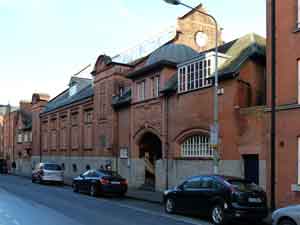IVEAGH TRUST PUBLIC BATHS
Published in Gems of Architecture, Issue 2 (March/April 2023), Volume 31Bride Road, Dublin 8
By Damian Murphy
In 1890 Edward Cecil Guinness (1847–1927), first Earl of Iveagh, established the Guinness Trust simultaneously in Dublin and London ‘for the amelioration of the condition of the poorer of the working classes’. Iveagh’s vision for Dublin was to provide new housing and associated educational and health-giving facilities to replace some of the tenement slums in the area around St Patrick’s Cathedral. The Bull Alley complex included affordable housing in Patrick Street (1901) and Bride Street (1904), a workman’s hostel known as Iveagh House (1904–5) and the Iveagh Trust Public Baths (1905–6). The designs were by the London-based Joseph & Smithem, supervised on the ground by the Dublin-based Kaye Parry & Ross, each building showing the same russet brick and sandstone construction with cartouches carrying the date of construction and the name of the Trust.
The Iveagh Trust Public Baths occupy the north flank of Bride Road, facing Iveagh House, and are made up of three distinct blocks. The centre, ‘expressly devoted to the pastime of swimming’, is rigidly symmetrical, bookended by mullioned blind openings and decorative segmental pediments, the granite ashlar podium pierced by lunette windows, the small openings overhead given elongated panelled aprons, coupled dormers combining with a full-length lantern to fill the interior with cleansing air and light from above. The boiler house at the Patrick Street end is appropriately functional in appearance and is in stark contrast to the ticket office at the Bride Street end, which boasts a short tower-like entrance with elaborate cartouche and squat dome.
The swimming hall, since remodelled, centred on a pool described by The Irish Builder (16 June 1906) as measuring ‘65 feet by 30 and affording a depth of water from 3 feet 6 inches for the novice to 6 feet at its deepest end for experts’. The hall included 47 changing rooms and a gallery whose whiplash ironwork was the only concession to the contemporary Art Nouveau fashion, the whole covered by an openwork steel roof with pitch-pine vaulted ceiling. The pool and hall were ‘embellished with white enamelled tiles producing a most agreeable effect on the eye’. The emphasis was on hygiene and, in addition to the pool, the facilities on offer included segregated hot and cold reclining baths, ‘an ample supply of shower baths, foot-baths, lavatories … and an excellent wash-house well equipped with washing, wringing and mangling machines’.
Demand for the baths fluctuated from the outset. The attendance in 1907 was described as ‘fairly satisfactory in view of the cold summer’; the sharp increase in 1916 was explained by the temporary closure of the Tara Street Public Baths and Wash Houses. The baths saw their best attendances when hosting swimming galas, team sports and water polo matches, when the gallery overhead heaved with spectators. The baths were sold to Dublin Corporation in 1951 and, following a period of terminal decline, finally closed in 1985. Photographs from the time show the pool in poor repair, with its once-gleaming white tiles stained yellow. The Iveagh Trust Public Baths have since been reborn as a gymnasium, the original swimming pool a distant memory, the gallery extended forward on all sides around a central stairwell, the spectacular openwork roof now casting light over rowing machines and treadmills.
Damian Murphy is Architectural Heritage Officer, NIAH. Series based on the NIAH’s ‘building of the month’, https://www.buildingsofireland.ie/

















